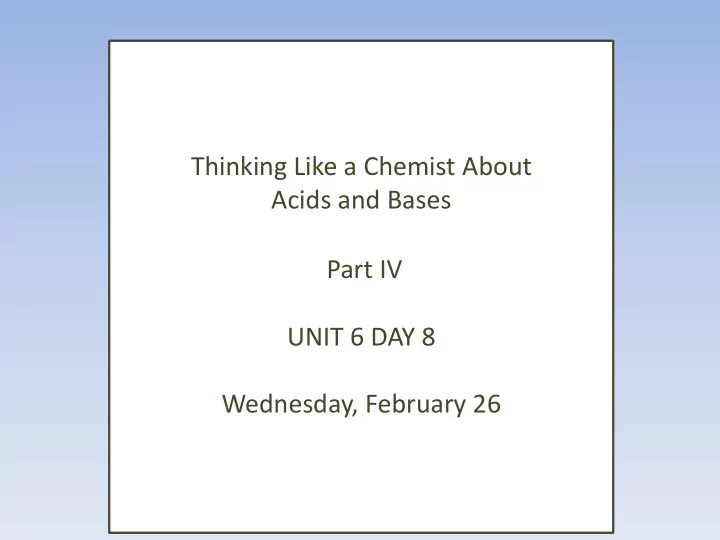

Thinking Like a Chemist About Acids and Bases Part IV UNIT 6 DAY 8 Wednesday, February 26
What are we going to learn today? Buffers Explore Acid – Base Titrations
Poll: Clicker Question Fully describe: Weak Base + Strong Acid reaction with resulting salt solution Write the chemical reaction and calculate the pH when a 200 mL 0.1 M solution of ammonia is mixed with a 100 mL 0.1 M solution of hydrochloric acid. K b for NH 3 = 1.8 x 10 -5 Before you do the calculation you should be able to predict if the resulting solution would be: A) Neutral B) Basic C)Acidic
Poll: Clicker Question Fully describe: Weak Base + Strong Acid reaction with resulting salt solution Write the chemical reaction and calculate the pH when a 200 mL 0.1 M solution of ammonia is mixed with a 100 mL 0.1 M solution of hydrochloric acid. K b for NH 3 = 1.8 x 10 -5 What is the pH? A. 4.7 B. 9.3 C. 7 D. 3.6 E. 10.4
Look at a DEMO Add a little NaOH to pure water and see what happens! Add a little NaOH to a 1:1 mixture of acetic acid and sodium acetate and see what happens! What is the difference?
Write down the neutralization reaction for the demo
Because the pH changed very little it is called a buffer solution. Buffer- a solution in which the pH resists change when a strong acid or base is added Buffers can be acidic Buffers can be basic
Because the pH changed very little it is called a buffer solution. What happens if we keep adding NaOH to the solution…..
Calculate the pH of buffer solution • 1 mole CH 3 COOH and 1 mole NaCH 3 COO in 1 L solution.
Derive a shortcut formula
Henderson-Hasselbach initial conjugate base initial weak acid When the initial acid and base are similar in concentration then the pH is close to the pKa For the pH to be 1 unit different than the pKa the difference in concentrations must be at least 10 X!
Poll: Clicker Question The pK a of HF is 3.18. What is the pH of solution of 100 mL of 0.1 M HF and 100 mL of a 0.2 M NaF? A. slightly less than 3.18 B. 3.18 C. slightly more than 3.18
Calculate the pH of a buffer system Calculate the pH of a buffer solution that is 0.15 M HNO 2 (aq) and 0.2 M NaNO 2 (aq) .
Compare the two solutions 0.15 M HNO 2 (aq) 0.015 M HNO 2 (aq) 0.2 M NaNO 2 (aq) 0.02 M NaNO 2 (aq) pH = 3.94 pH = 3.94 Any important differences between the two?
• You have a buffer solution containing acetic acid and acetate ion. You adjust the pH to be 3.75. Which is present in the higher concentration: the protonated or deprotonated molecule?
Calculating pH of a Buffer 1. Look at what you are given, and think like a chemist. 2. Is the buffer acidic or basic? 3. Has additional acid or base been added to the buffer system? 4. If so, complete the neutralization reaction, and calculate the concentration of the buffer components 5. Choose the correct version of the Henderson-Hasselbalch equation. 6. Using the equation, calculate the pH. All this is on website. Two worksheets for practice. Practice makes perfect.
Poll: Clicker Question What is the purpose of a buffer? One needs to keep an unusual microbial species alive in a laboratory setting. The microbe survives best in an alkaline environment with a pH > 9. The best choice of a buffering system would be equal molar amounts of: + , K b = 5.6 x 10 -4 A) C 2 H 5 NH 2 , C 2 H 5 NH 3 + , K b = 3.8 x 10 -10 B) C 6 H 5 NH 2 , C 6 H 5 NH 3 - , K a = 1.2 x 10 -2 C) HClO 2 , ClO 2 D) HOCl, OCl - , K a = 3.5 x 10 -8
Choosing a Buffer The best situation is: Relatively high concentration of conjugate acid-base partners. One to one molar concentration will buffer against both added acid and added base. One to one molar concentration – buffer will have a pH = pKa. PRACTICE! HOMEWORK & WORKSHEETS!
What did we learn today? Weak acids or bases have limited ionization in the presence of a common ion. Substantial amounts of conjugate acid base pairs, together in solution resist change in pH. • This effect is called buffering. • When [HA] = [A - ], the pKa = pH of that solution. • When [B] = [BH + ], the pKb = pOH of that solution.
IMPORTANT INFORMATION HW07 LM22 – Titrations LM 23 Exam 2 – Tuesday, March, 4 th - Rooms TBA
Learning Outcomes Understand the concept of a buffer, buffer capacity and buffering range. Calculate the pH of a buffer solution. Show mastery of the Henderson-Hasselbalch equation Calculate the pH of a buffer solution after the addition of a strong acid or strong base.
Recommend
More recommend